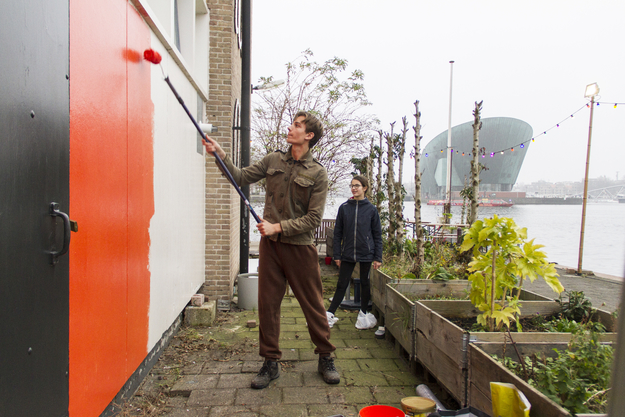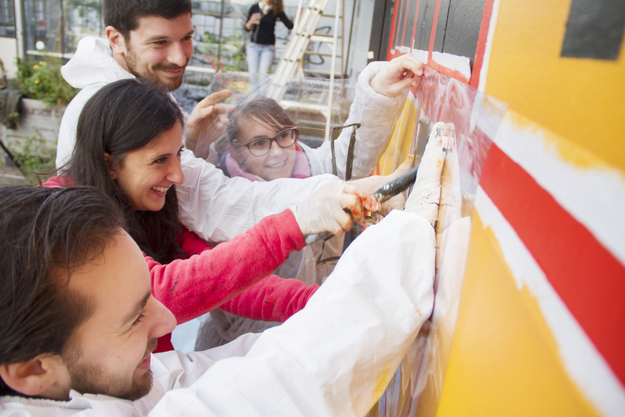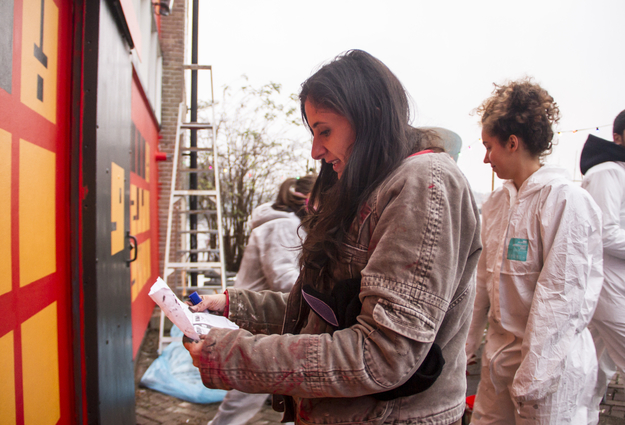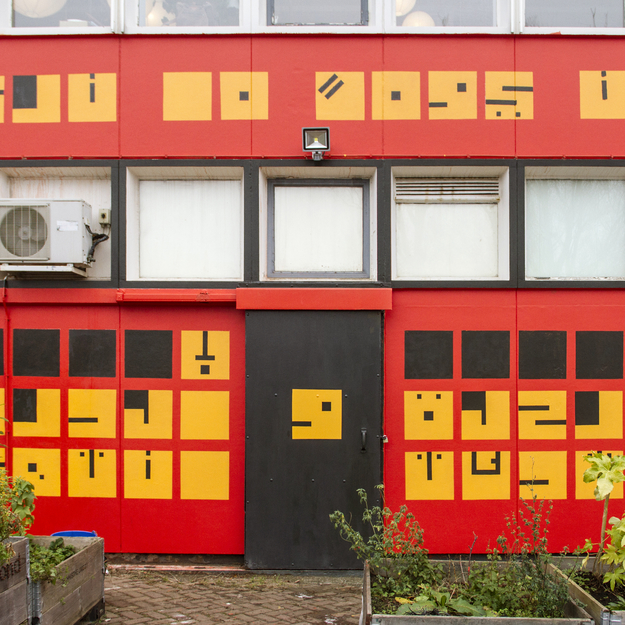Artist Talk
On Sunday 11 December Bahia will by giving a short artist talk about the state of graffiti in Egypt after the revolution in addition to showcasing some of her own work.
Mural & Participation
The mural will be created on the wall of Mediamatic Biotoop, next to our harbour and terras. If you want to participate in the making of the mural you can send us a message via facebook.
A Thousand Times No
Bahia Shehab became a political activist during the Arabic Spring when she decided to transform her earlier research and exhibited art project about Arabic calligraphy into graffiti in the streets of Cairo. Her street art features the arabic script 'No' together with different political claims such as "No to violence" and "No to military rule", always linked to cases of abuse performed during the protests. Especially iconic is the "blue bra" which Bahia started spraying after a woman was stripped of her clothes and beaten by the police - exposing the blue bra underneath.
“You can crush the flowers, but you can’t delay spring."
The artist is continuing her research about historic Arabic calligraphy as a PhD candidate at Leiden University, pursuing to create an encyclopaedia of the Arabic script. She takes an active role now of inspiring our young generation by teaching and mentoring students of the Arts Department at the American University of Cairo. There she developed a design curriculum that focuses on Arabic visual culture and how to maintain this heritage in our modern world, which for example lacks in diversity of especially Arabic digital fonts.
"Graffiti is like flowers. They are beautiful, but they don't live long." An interview with Lebanese-Egyptian street-artist Bahia Shehab about the role of art during the Arab spring: "You cannot resist ideas. They can travel into any mind."
"I am a quiet person, I don't know how to scream", says Bahia Shehab. "My contribution to the revolution was to paint on the walls, was to be an artist." During the Arab spring many artists felt the urge to rush to the streets, Shehab explains. At the time, there was no tomorrow, one did not think of possible repercussions, she says: "When you loose hope with everything around you, you go down to the street. Your only hope is the people. This is who you paint and work for. It's their minds, you try to influence."
At the time Bahia became known for a series of graffiti centred around the word 'no' - No to Military Rule, No to Emergency Law, No to Stripping the People, No to Blinding Heroes, No to Burning books, No to Violence, No to Stealing the Revolution, No to a New Pharaoh besides others.
"Our work gets erased very quickly on the street. That's why TV and the internet are very useful tools - you can communicate your messages in the digital sphere. That's the game-changer now. The government can resist you, it can try to hide, what you try to communicate, but it's a completely different ballgame now."
"I believe, that art can change lives", Bahia Shehab continues: "It's a very powerful tool. It's a therapy. In some civilisations art is used to cure you from a disease." Art can be perceived by anybody on different levels. The more art there is in the public sphere, the better the society around it.
"In our case, we are not trying to install beauty. We have not yet reached that level. We communicate ideas of change to society. Because we believe in change and we believe in art as a tool for change. We are still on survival mode."
"It takes time to create change. New ideas are always opposed. Humans like normality, we like our comfort-zone. they don't like change, that is drastic. But enlightenment is not selective. Some people keep dreaming. Dreaming of a better future. We hope to grow the circle of dreamers. Society is not driven by people, that are pragmatic and realistic. It's only driven by the crazy ones, the dreamers."
Bahia Shehab (b.1977) is an artist, designer and Islamic art historian studying ancient Arabic script and visual heritage. Shehab is a Creative Director with MI7-Cairo working on projects relevant to cultural heritage and she is also associate professor of professional practice at The American University in Cairo. She has developed and launched the new graphic design program for the Department of the Arts with courses mainly focused on the visual culture of the Arab world. She is currently a PhD candidate at Leiden University in Holland. Her research is on Fatimid Kufic inscriptions on portable items in the Mediterranean basin and beyond.
Bahia Shehab was interviewed by Marc-Christoph Wagner
Filmed by Steen Møller Rasmussen
Edited by Kamilla Bruus
Produced by Marc-Christoph Wagner
Copyright: Louisiana Channel, Louisiana Museum of Modern Art, 2014
Supported by Nordea-fonden
Prins Claus Award
For the past 20 years, the Prince Claus Fund has honoured visionary artists and organisations for their excellent, pioneering work in culture and development. On Thursday 15 December, HRH Prince Constantijn of the Netherlands will present the 2016 Prince Claus Award to graphic designer, artist, educator and historian Bahia Shehab. The Prince Claus Awards Ceremony will be held in the presence of members of the Dutch Royal Family at the Royal Palace Amsterdam. This is an invites only ceremony.Go here to see the other lecturates and full jury report.
Information
Political Stenciling with Bahia Shehab
Live Stencilling: Sat. 10 (12:00 - 18:00) - Sun 11 + Mon 12 December (10:00 - 18:00)
Artist introduction: Sun.11 December 17:00
Free Admission
Mediamatic Biotoop, Dijkspark 6, Amsterdam












